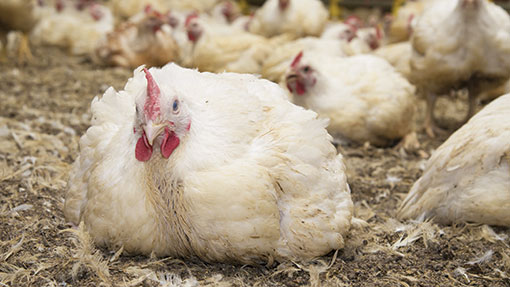Rule change review for Red Tractor poultry scheme

Getting on top of campylobacter is the driving force behind a number of changes to the Red Tractor poultry scheme in the latest “refresh”, which comes into force from 1 October this year.
For the first time, producers will have to keep a physical barrier at a minimum height of 30cm, rather than a painted line, in the ante-room of sheds, creating a biosecure partition.
The area beyond the barrier must have “clean” shoes that can be changed into and there should be a seating area to aid the transition. And the barrier must be easily washable, or removable for cleaning.
“Having a white line painted on the floor wasn’t as effective,” says Catherine Lehane, a technical manager for Red Tractor. A physical barrier has been introduced now as it is one of the few interventions known to help contain campylobacter.
Biosecurity
Renewed focus has been placed on tight hygiene controls generally on poultry units. “In the old manual there wasn’t a section for biosecurity, it was tacked on to animal health. It didn’t really have the impact, so we took it out and made each point a standard,” says Ms Lehane.
This means data can be interpreted more easily, informing ongoing work on how biosecurity affects campylobacter levels. It also makes practices easer to enforce.
Free-range broiler growers will also have to designate a biosecure area for their farms, either encompassing the whole farm, or the shed and ranges around it.
Labour
The requirement for staff on broiler units to be enrolled in the Poultry Passport scheme has been rolled out to all chicken standard schemes.
New employees are now required to have an induction, and existing workers should have their competence regularly checked.
Furthermore, those using a labour provider must now check for a valid Gangmasters Licence. There must be documentation between the two parties proving eligibility to work.
Antibiotics
“Antibiotics is a really hot topic,” says Ms Lehane “We’ve done something across all livestock and all schemes. With the poultry sector, however, we feel the industry has done quite a lot already.”
New to the latest version of the assurance scheme rules is the requirement that producers record all antibiotics used on farm, specifying the total antibiotic use of each crop.
Fluoroquinolones, subject to a voluntary industry ban since the beginning of 2012, are now not permitted in broiler chicks reared under Red Tractor. Indeed, all routine use of antibiotics on day-old birds is no longer permitted.
Second- and third-generation cephalosporin medication is now formally not allowed, following previous industry moves to avoid their use.
Water and windows
The recommendation that producers have a water alarm system has been dropped. Although not a formal requirement, it had proved problematic with those on mains water supplies because fluctuations in local water usage would often set them off. A requirement now means businesses must have a contingency plan in case the supply of water is disrupted.
Another new recommendation is that windows be installed, where possible. This, explains Ms Lehane, is because the assurance body doesn’t yet have any data on the practice. By recommending it, inspectors will record it, and a picture will emerge surrounding the effects they may have on welfare and the shed environment. One reason it’s not become a full standard, however, is because LED lighting is becoming more common on farms, and is able to replicate daylight without the “dappling” effect of changing weather conditions from the light through windows.
Online portal
One development in the pipeline is an online portal that scheme members will be able to upload records to. The idea is to allow inspectors to review documentation via a private website before visiting a farm. “A lot of people are moving toward electronic record keeping,” says Ms Lehane. “It won’t be mandatory, but it will save time. The inspection will take as long, just not for the farmer.”
